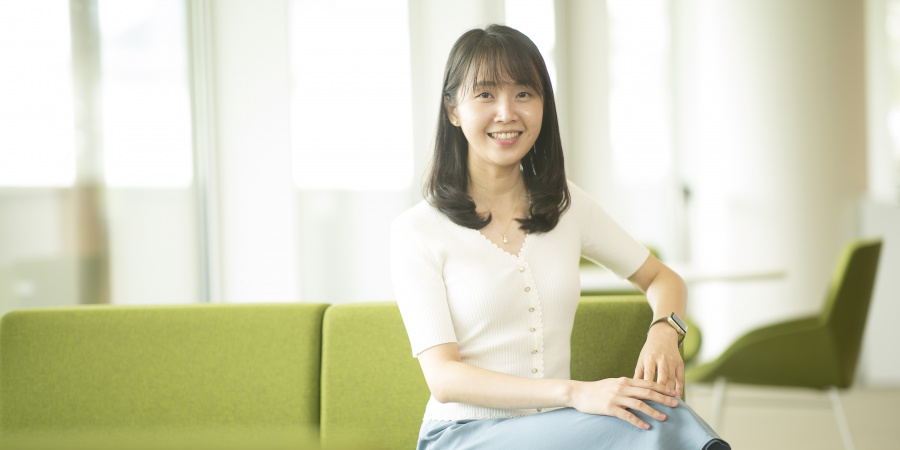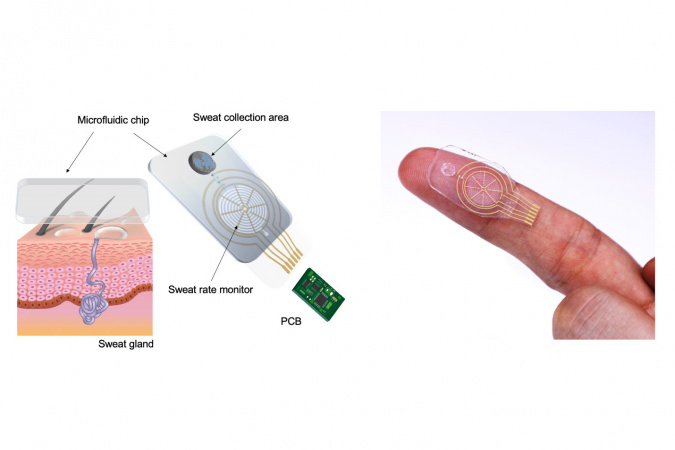Decoding Our Body’s Secret Through Sweat
The academia knows no boundary. The world’s brightest young researchers are often spoiled with choices when it comes to deciding where to advance their career. For Prof. Hnin Yin Yin NYEIN, HKUST comes across as a clear front-runner after experiencing first-hand the faculty members’ undeterred commitment to research. Since setting foot in Hong Kong, she has not looked back.
The wearable sweat sensor
Born and raised in Myanmar before university, Prof. Nyein headed to the United States for higher education. She gained her bachelor’s degree and PhD in Materials Science and Engineering at the University of California, Berkeley, and joined Stanford University as postdoctoral fellow upon graduation. She is a recipient of Innovators Under 35 Asia Pacific 2021 from MIT Technology Review, and her research was published in acclaimed scientific journals such as Nature. Relocating to Hong Kong upon joining HKUST as an Assistant Professor at the Department of Chemical and Biological Engineering (CBE), Prof. Nyein is excited for the journey that lies ahead.
Prof. Nyein’s research focus is on flexible wearable biosensors designed for personalized healthcare. She developed a state-of-the-art wearable sweat sensor that makes use of resting sweat as a constant biofluid source for assessing health metrics at a molecular level. The device gives a robust and accurate analysis of user’s health information, and can be mass-produced cost-effectively, allowing users to continuously capture and monitor their biomolecular information and keep track of their health condition.
“Nowadays smartwatches with health monitoring features are commercially available, but none of them accesses users’ health information at a biomolecular level,” says Prof. Nyein. “Sweat, which contains a wealth of insights representing the dynamics of our bodies, is an underutilized resource with enormous potential in facilitating active, non-invasive, and accurate health monitoring.” The wearable sweat sensor developed by Prof. Nyein is set to prioritize diagnosis and treatment over reactive healthcare by routinely providing users with insights into their own physiology, thereby empowering them to become proactive agents in monitoring their own health.
“The sweat sensor will benefit health management from many aspects, and could potentially transform the diagnostic methods for specific diseases.” Prof. Nyein adds. One of the diseases is cystic fibrosis (CF), where measuring the chloride ion level in sweat is the golden standard for diagnosis. The conventional sweat test required patients to sit still while their sweat glands are stimulated for collection, and patients would have to wait patiently for the lab results. Prof. Nyein’s sweat sensor, on the other hand, offers near real-time sweat stimulation, collection, and analysis in one wearable. This is made possible as the sensor allows for local sweat stimulation. It is also optimized to enable rapid uptake at ultralow sweat secretion rate, and it performs immediate sweat composition measurement and analysis.
Expanding the applications
“The technology could have broad applications. It can also be used to measure other molecular constituents of sweat,” says Prof. Nyein. “If a disease’s indicator is involved with sweat biomarkers, we can collaborate with healthcare professionals and modify the sensor technology for a specific application.”
The sensor’s application is not limited to disease diagnosis and treatment. It is broadly amenable to a number of disciplines, for example, the sports science regime. “We can use it to estimate an athlete’s body fluid loss, electrolyte loss, and of course, sweat loss,” says Prof. Nyein. “We are already having conversations with sports labs and athletes to conduct further studies. This could potentially benefit athletes by helping them find their best condition and optimize their performance.”
Moreover, studies conducted have linked sweaty palms with psychological stress level. The sweat biosensor can therefore be utilized to inform a person’s level of stress. “We performed a test and asked the participants to wear a sensor on their finger while giving a lecture. The results show that when a person is under stress, the sweat rate jumps up.”
Up next
In the coming five years, Prof. Nyein’s goal is to acquire a large set of data and map out a baseline representing a healthy and equilibrium body condition. If a user’s sweat measurements deviate from the healthy baseline, it might be an early indicator of a developing health condition, warning the user to get a medical check-up.
To uncover the actionable correlations between sensor measurements and health status, it is essential to bring on board experts with core competencies in data analytics. “We will need help from big data and machine learning specialists to analyze the large database and extract meaningful insights,” says Prof. Nyein. “Lots of interdisciplinary and collaborative research will be required for this idea to become successful.”
A brand new chapter
Impressed by HKUST’s research culture and faculty members’ genuine passion in their research area, Prof. Nyein chose the University as the next stop of her academic venture. “I spoke with the CBE professors during my interview. They are very energetic and passionate about research, and are extremely supportive toward the research area that I am working on. They are the ones that really convinced me to come,” says Prof. Nyein with a smile. “After seeing the campus view and research facilities upon arrival, I felt like I have made the right choice.”
Prof. Nyein sees engineering as a discipline that marries theory and practice, and finds it immensely rewarding to be able to bring an idea to fruition. “To me, a university presented the best research environment. Here my ability will not be limited by corporate business goals, and it allows me to focus more on advancing science and technology.”
For students who are interested to embark on a research journey, she highlights two fundamental qualities of a successful researcher. “The first thing you need is passion. It will be the internal drive that motivates you to discover new things. The next thing you need is perseverance. Great research discoveries or breakthroughs may take years, countless times of failure is inevitable in the process. It’s important to not give up and remain undeterred through it all,” says Prof. Nyein.
Teaching with an interdisciplinary approach
Propelled by a sense of civic duty and responsibility, Prof. Nyein believes that bringing a positive impact to the society is the ultimate goal of every research endeavor, and she looks forward to passing on her expertise and knowledge to students, empowering them to become an agent of change for the society in the future.
“Not every career gives us the opportunity to do what we love while enabling us to mentor the younger generation and help them make a real-world impact,” says Prof. Nyein. “I am proud and honored to be able to do both at HKUST at this stage of my career.”
When it comes to teaching, Prof. Nyein’s approach is to engage students by connecting the new concepts with their previously acquired knowledge. She establishes relevance through explaining how theories can be applied in different disciplines, and enriches students’ perspective of thinking by linking applications to current real-life issues.
“I got students from many different disciplines. Some of them specialized in biology, some in chemistry, and some in engineering,” says Prof. Nyein. “So I gave examples in the context of different disciplines and helped students relate their own knowledge to these new concepts. Being able to resonate with a topic would deeply enhance their interest in learning.”
Women in engineering
Speaking of women in engineering, Prof. Nyein observed that there are more women in the bio-related fields typically when compared to other engineering fields. She recalled that almost half of the researchers around are female during her time at Berkeley and Stanford. “I found this particularly encouraging, as it reflects that women are given the opportunity and platform to do what they love,” says Prof. Nyein.
Real-life female engineers are the best advert for the profession. Rallying more female flag bearers and ambassadors could be one of the ways to revoke engineering’s conventional image. “The leading computer scientist who first captured a black hole image was also a woman,” says Prof. Nyein. “We need more impactful female role models alike to encourage the younger generation to pursue STEM.”
Being a renowned young researcher with a steadfast commitment in her field of study, Prof. Nyein continues to inspire and encourage new generations of engineers to pursue their own ideals. “Be courageous, be persistent, and show them what you’ve got, so no one can stop you,” concludes Prof. Nyein.


